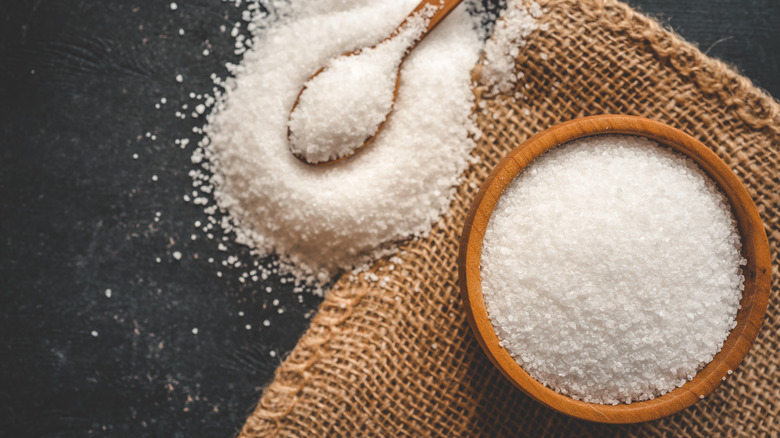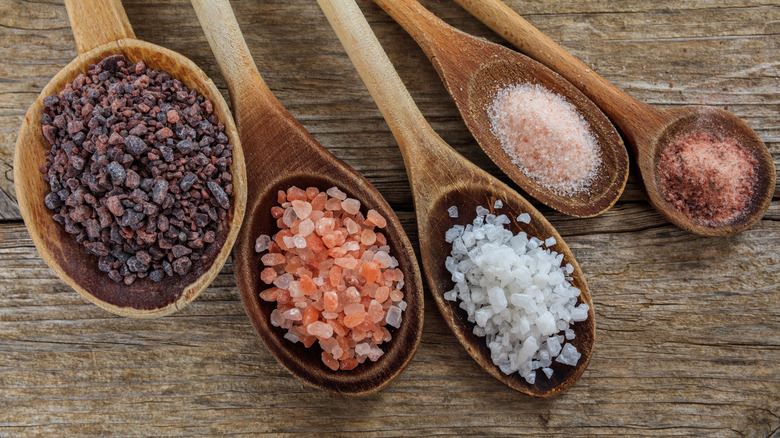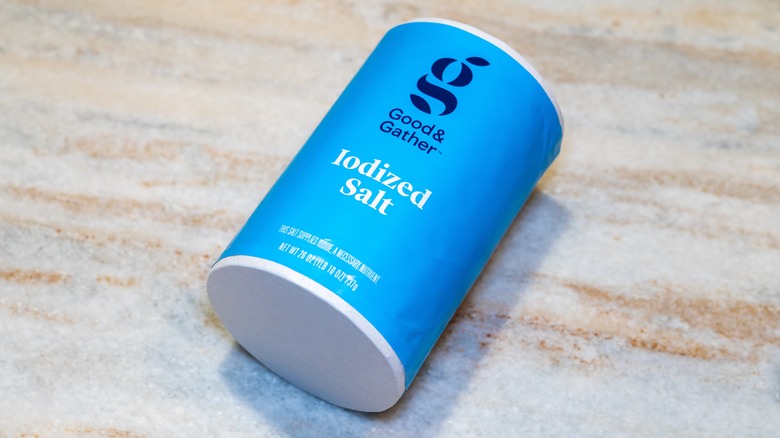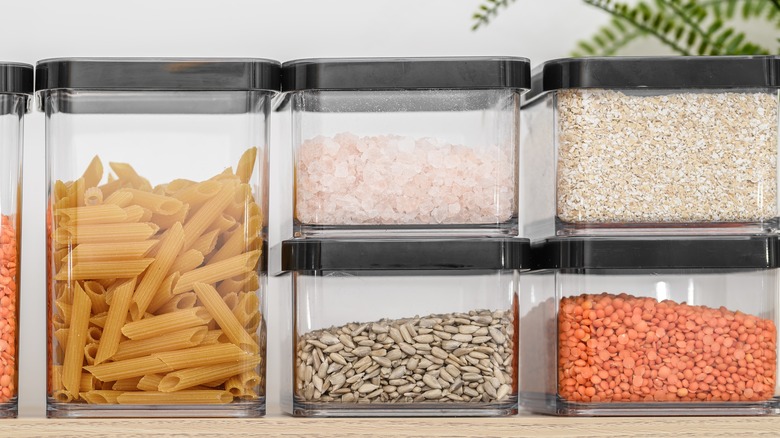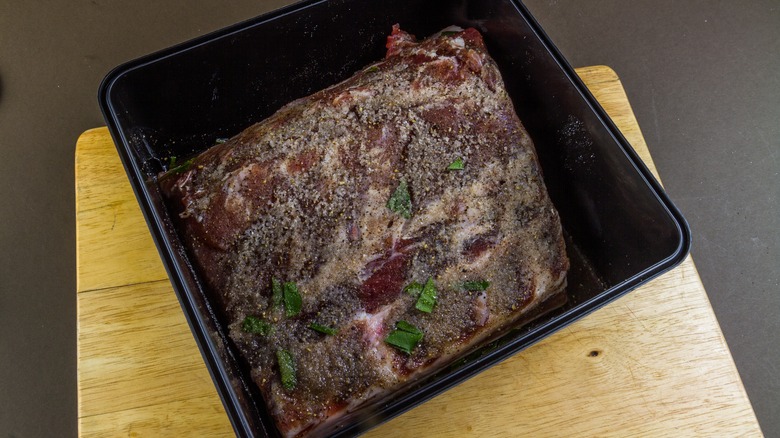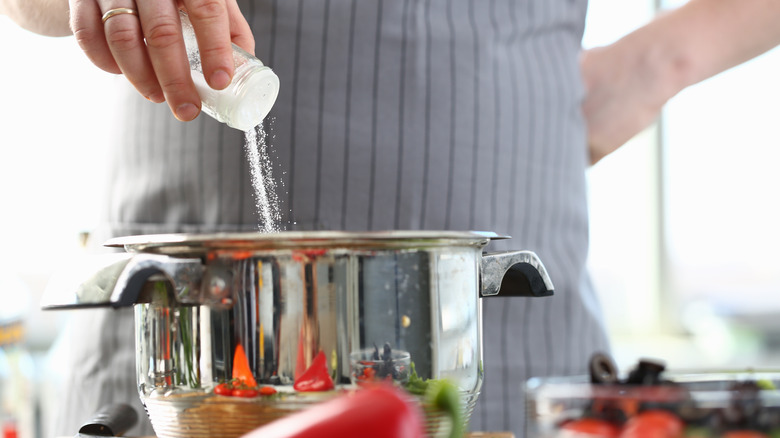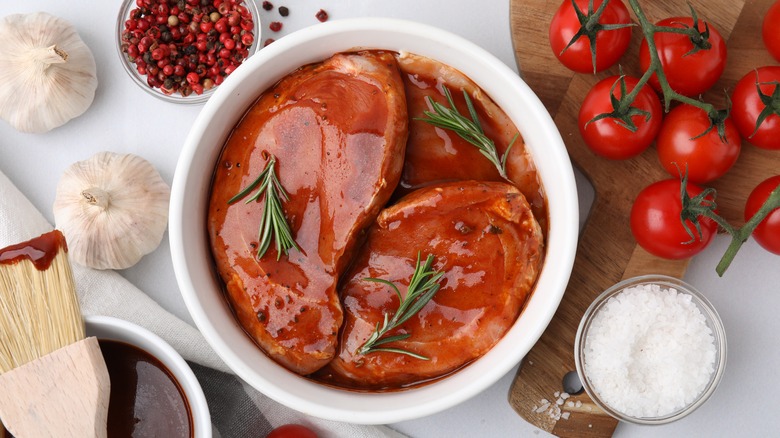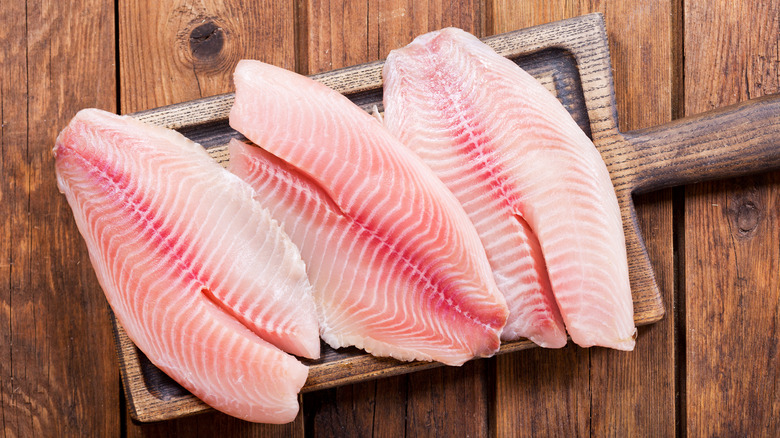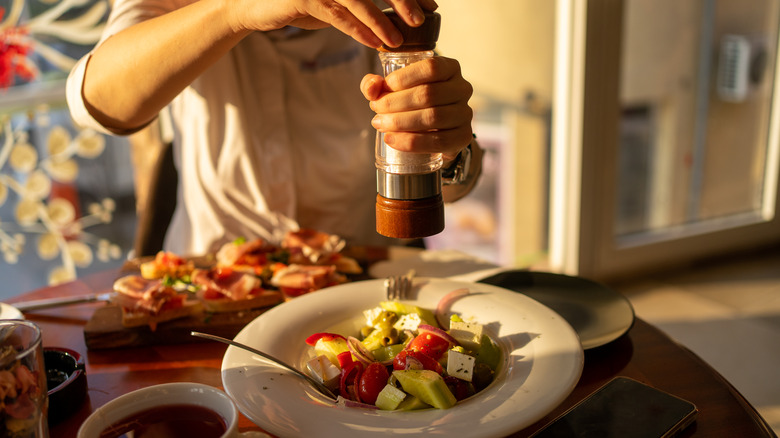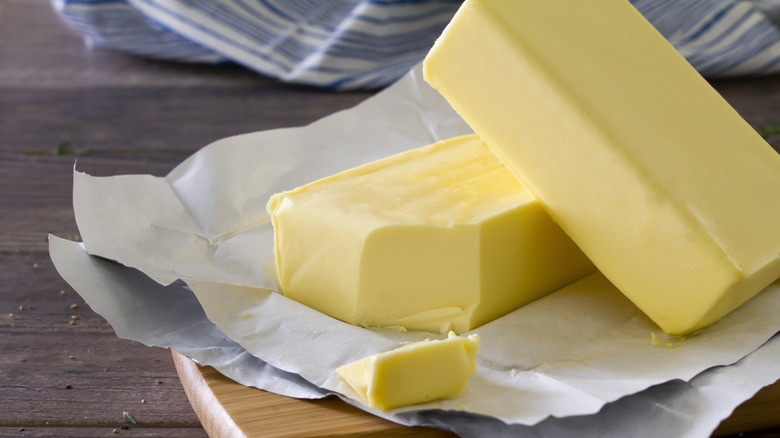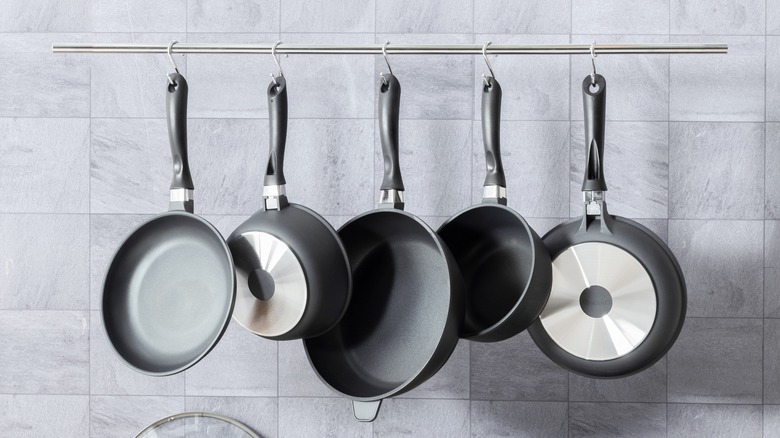12 Mistakes Chefs See Everyone Make When Cooking With Salt
Alongside pepper, salt is the most utilized — and useful — seasoning in the kitchen. The tiny white granules not only enhance flavor but can also mask any funky notes and bitterness in food. Sodium can also change the texture of meat, fish, and even vegetables, making them more tender and appealing. With so much on the table, it's not surprising that most of us think we've got this whole salt thing down pat. Many of us don't pause to question what type of salt we are using and how much of it we sprinkle in our food. This can be counterproductive, resulting in oversalted meals, mushy proteins, and dishes that lack the subtle balance of flavors that impresses dinner guests.
Everyone makes mistakes in the kitchen from time to time. Since salt is such a common ingredient, it's often the culprit behind our blunders. To make your next kitchen adventure more successful, we consulted five chefs and culinary professionals to discover the most common salt mistakes made by home cooks. Sean Blomgren, executive chef at The Lodge at Spruce Peak, and Jose Gutierrez, executive chef at the Hilton Barbados Resort, are experts at using salt to keep restaurant guests happy. We also spoke with Richard LaMarita, chef-instructor of Plant-Based Culinary Arts at the Institute of Culinary Education, Kolby Kash, a culinary author with a vast online presence, and Brandy Hackbarth, chef and owner of Dining by Design — all of whom were eager to share their salt advice with home cooks looking to elevate their seasoning game.
Using the wrong kind of salt
A lot of home chefs think that all salt is the same, and at its essence, it sort of, kind of is. All salt is made up mostly of sodium chloride, often with a little anti-caking agent to keep it from clumping. But when it comes to the nitty-gritty of it all, different salts vary in texture, flavor, and how they dissolve in liquids. All of these elements can affect the final flavor of a dish. Sean Blomgren sums this up, saying, "A tablespoon of fine table salt is way saltier than a tablespoon of kosher. I always weigh salt and stick to a 2% to 2.5% [salt to ingredient] ratio for consistency. At home, I use the same salt every time so I know exactly how it feels and tastes."
Many chefs let personal preference dictate their choice of salt. Richard LaMarita says that he usually uses fine natural sea salt or Himalayan pink salt for everyday cooking. "The grain feels nice and fine; the salt contains beneficial minerals such as magnesium, potassium, calcium, and iron; and the flavor is complex," he adds.
Beyond this, LaMarita notes that he normally uses Kosher salt for seasoning proteins. Its flakiness and lightness make the mineral easy to dust evenly over ingredients. For baking, LaMarita prefers non-iodized sea salt or table salt, as its small grain size allows for more precise measurements and even distribution across baked goods.
Opting for iodized table salt in cooking and baking
If you have ever come across iodized salt at your local grocery store and weren't entirely sure what it meant, here is a quick run-down. Iodized salt is your standard table salt that has been fortified with a tiny amount of iodine to help prevent iodine deficiency. While iodized salt may do wonders to prevent goiters or generally help prevent iodine deficiencies, this type of salt isn't necessarily the best choice for day-to-day kitchen projects, as explained by Richard LaMarita. "I tend to stay away from highly refined table salt with added iodine," he says. "It is sharp and intense without much complexity as it is stripped of its natural colors and minerals."
Iodized table salt can be particularly problematic in baking due to its strong flavor. Kolby Kash avoids using iodized table salt in his baked goods for precisely this reason. "Iodized table salt has a much finer grain and a sharper, almost metallic taste that can throw off your flavor balance, especially in baking," he explains. "It dissolves too quickly and can lead to uneven salting in doughs or batters." Bakers, take note.
Not storing salt correctly
Pure salt doesn't expire. However, any commercial salt additives, such as iodine and anti-caking agents, can slowly degrade over time. This can make your salt clumpy (a surefire sign that it may be the right time to ditch your salt). This is precisely why salt packaging normally specifies the product's expiration date. The bottom line — while consuming salt that has seen better days isn't going to make you sick, it may result in an underwhelming culinary experience.
Not to worry — there are easy tricks to keep your salt fresh for longer. Step one involves transferring it out of its original packaging after it has been opened. Given that salt absorbs moisture (hence the clumping) and odors from its surrounding environment, the best place to store this kitchen staple is in an airtight container. Opt for a glass jar, a food-grade plastic container, or even a vacuum-sealed food storage bag, but stay away from anything made out of metal since salt is a corrosive that can break it down over time, absorbing trace amounts of the substance. Once safe and sound in an airtight container, it's best to store salt in a cool, dry spot away from heat and humidity.
Never adding salt to sweets
The idea that sweet and salty flavors don't belong in the same culinary creation is an all too common misconception. In reality, a pinch or two of sodium can both balance the sweetness and sharpen the overall flavor of tempting treats, benefiting everything from a chai peach clafoutis to banana cream pudding eclairs. Whatever your guilty pleasures, be sure to keep your salt shaker handy the next time you decide to bust out your baking game.
Brandy Hackbarth says that a touch of salt can go a long way when it comes to desserts. "It balances bitterness and enhances sweet and sour notes. A pinch of salt can deepen the richness of chocolate or make baked treats taste sweeter," she says. "If you need to limit sodium, try using premium finishing salts once your goods are cooked. A light sprinkle of flaky sea salt adds a pleasant crunch and burst of flavor without adding too much sodium."
Forgetting to use salt to dry-brine meat and fish
Jose Gutierrez is a strong believer that overlooking the effect of salt on the texture of meat and fish is a huge mistake. "It can tenderize meat, draw out moisture, or, if used incorrectly, make food tough," he explains. "Understanding this is key to proper seasoning. For example, while we can add salt to make the fish have a better texture, this can also lead to a drier fish."
One way to use salt to enhance the flavor and tenderness of meat and fish is through dry brining. This method involves rubbing the surface of the protein with salt and spices, then letting it sit for anywhere from 45 minutes to 24 hours in the refrigerator. Sean Blomgren, who swears by dry-brining his turkeys, breaks this technique down, saying, "Salt draws out moisture, then reabsorbs it, carrying flavor deep into the muscle and improving texture."
According to Brandy Hackbarth, aside from brining, salt can also be used to help make caramelized onions and sauté holy trinity (otherwise known as the combination of onion, bell pepper, and celery). As she puts it, "Adding salt early helps draw out moisture and speeds up the development of richer flavors, improving both texture and taste."
Relying solely on salt for flavor
While using salt properly can transform a dish, relying on salt alone can leave food tasting flat, uninspired, or just overly, well, salty. After all, it would be a shame not to use the numerous herbs and spices that work well alongside salt to give food depth and character. Kolby Kash says that many home chefs fall into the trap of thinking that more salt equates with better taste, while in reality, flavor comes from a balance of acid, herbs, spices, and umami. "If your dish feels flat, reach for lemon juice, vinegar, soy sauce, or a pinch of sugar before adding more salt. You'll get a more balanced bite without overpowering your palate," Kash says.
Richard LaMarita explains that salt brings out flavor in food through a complex, scientific interaction between salt, our taste receptors, aroma, and flavor molecules. He also highlights that since salt can only amplify what is already in the pot or on the plate, relying on it alone for flavor is a mistake. "There are so many other tools a cook should use to create a delicious and satisfying dish," he says. "The use of aromatics like onion and garlic, spices and herbs, acids such as lemon, wine, and vinegar, and fats such as olive oil or butter, all can contribute to the overall flavor of a dish."
Not taking into account salty ingredients
Many everyday ingredients are loaded with salt, so adding more sodium to a dish without accounting for them can mess with its flavor balance. The goal of cooking it is to layer flavors, not create a salt bomb that's going to leave everybody desperately reaching for a glass of water. Richard LaMarita urges home cooks to consider the saltiness level of the other ingredients in a dish prior to salting. "Think about Moroccan-cured olives, Parmesan cheese or feta, pancetta or prosciutto, anchovies, soy sauce or miso, kimchi, sauerkraut, capers, or salted nuts," he says. "These items will naturally add salt, so to keep the dish balanced, you must compensate with your seasoning touch."
Brandy Hackbarth points out that even the ingredients you wouldn't normally expect to be salty — such as celery seeds, dill, thyme, and even tomatoes — can quietly crank up the sodium levels of your kitchen creations. "When cooking, it's best to begin with the low-sodium options and then gradually add salt, particularly in soups and stews," she says. "Since liquids reduce, the saltiness will concentrate over time, and flavors intensify during cooking. Also consider using miso paste and nutritional yeast versus salt in recipes. Not only will you get saltiness, but you'll also get umami."
Not dissolving salt properly in marinades and brines
As long as we don't go overboard, meat and fish can make an incredible vehicle for other flavors. And one of the best ways to infuse them with layers of aromatic notes is through marinating and brining. Marinades usually consist of oil, acid, and spices, while dry brines typically skip the oil (hence their dry status). In fact, it's not uncommon to dry-brine meat just with salt.
While salt plays a key role in dry brines and marinades, it's not enough to just add the mineral to the mixture — you need to make sure that it's been fully dissolved. In the case of dry brine, be sure to uniformly distribute the sodium across the entire surface of the meat or fish. Salt that's not dissolved or evenly spread out can result in uneven flavor, with some overly salty patches of food and others that are too bland. It can also lead to inconsistent texture, which can affect how the protein cooks.
Salting some foods too early
While dry brining meat and fish can imbue them with flavor and improve their texture, if not done correctly, it can have the opposite effect. We certainly don't recommend only salting food after it's served, but some proteins shouldn't be sprinkled with salt too early during the cooking process. So, how do you know when to salt and when to bide your time? Well, it depends. For larger and more sinewy cuts of meat, it pays to apply salt early, since the process can actually make it more tender by breaking down its muscle fibers. On the flip side, salting delicate foods too early can spell culinary disaster.
Generally, smaller and more tender cuts of meat and flaky fish don't need to be salted for hours before hitting the pan — in fact, the move would be counterproductive. Seafood and tender cuts of steak, such as tenderloin, New York strip, and ribeye, don't really need a lot of time to absorb salt. Seasoning them too early is also likely to actually cure the meat, making it firmer and affecting the browning process.
Only sprinkling salt at the end of the cooking process
The phrase "add salt and pepper to taste" appears at the end of most recipes. While there is a lot to be said for sprinkling your meal with a dusting of sodium once it's been served, this is not the only time you should be thinking about the seasoning. Kolby Kash is adamant that salting throughout the cooking process can add much-needed depth to a meal. "Salt draws out moisture and concentrates flavor as food cooks," he explains. "When you season at multiple stages — a pinch at the start, a touch midway, and a final flourish at the end — you develop layers of flavor instead of surface-level saltiness."
Richard LaMarita agrees, saying that sprinkling salt into dishes as they cook plays a key role in well-prepared meals. Professional chefs and culinary experts, he explains, can easily tell when salt is just added at the end, comparing the practice to a "quick paint job." LaMarita adds that seasoning added as an afterthought often just sits on the surface of the food.
To get the most flavor out of — or into — your food, LaMarita advises home cooks to use salt at intervals throughout cooking. "Season when you are sweating aromatics; season when you add liquid to the dish," he says. "Season your main protein items. Season early and often. ... A bit here, a bit there, and you will be building flavor into your dish, allowing the salt to do its job of bringing out the flavor by releasing moisture and allowing the salt to penetrate deeply into ingredients for an overall balanced, well-rounded flavor."
Not fixing overly salty food
Salt bombs can happen to even the most experienced chefs. A sprinkle here, a dusting there, and suddenly you are feeding what should have been a culinary masterpiece to the dog. Rather than throwing the meal into a trash can, there are plenty of ways to contain the damage.
"The key is knowing how to recover," Kolby Kash says. "If your soup or sauce is too salty, add unsalted broth, water, or cream to dilute it. For stews, throw in a peeled potato to absorb excess salt (then discard it). And for over-salted meats, balance with acid — a squeeze of lemon or a drizzle of vinegar can neutralize the bite of too much salt and bring the dish back to life."
The options for fixing an overly salty meal are endless. For example, the Austrian-born American chef and restaurateur Wolfgang Puck says that the key to balancing out salt is fat. Whether it's cream, butter, whole milk, or sour cream, this extra fat can work wonders to soften the taste of salt. Fat also coats the palate, masking any harsh undertones in the food. If you are a vegan, swap fat-rich dairy for a little avocado, or a dash of full-fat coconut milk or olive oil.
Failing to understand how salt interacts with cookware
If you think salt only affects food, you are mistaken. Jose Gutierrez explains, "Salt can react with cookware: it may pit cast iron, damage nonstick coatings, or affect flavor. Understanding material interactions ensures safe cooking, preserves your pans, and maintains consistent results."
So, how do we ensure that our food tastes great without ruining our pots and pans? One huge no-no is adding salt to a stainless steel pot of water before it comes to a boil. If the undissolved crystals make their way to the bottom of the pot, they can cause pitting or corrosion of the pot's surface. In addition, while salt crystals are often recommended as a cleaning agent for cookware, using salt on aluminum, stainless steel, or nonstick pans can actually damage or scratch their surface. That said, salt is still a great cleaning option for sturdier materials such as enamel, cast iron, ceramic, and glass.
